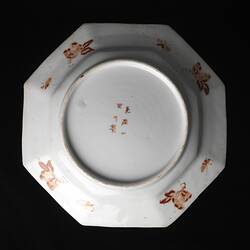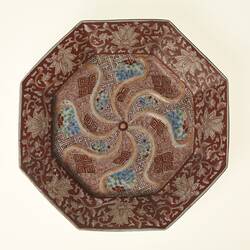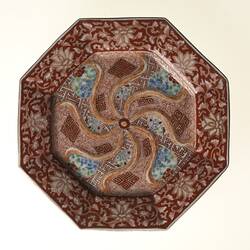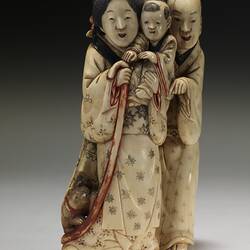Summary
Imari plate featuring a distinctive pinwheel design with a peony and foliate border, produced by Hichozan Fukagawa in Arita in the late Edo - early Meiji period (1856-1875). The signautre on the vase reads Hichozan Fukagawa Sei (Fukagawa made) indicating it was created between 1856 and 1875. Fukagawa Eizaemon established Koran-sha Company in 1875 and the signature changed at this time.
Imari porcelain ware takes it name from the port-city of Imari in the Saga Prefecture on the southern island of Kyushu, Japan. From the late 17th century, Imari porcelain was extensively exported specifically for the European market. In Japan, this type of porcelain is also referred to as Arita-yaki, as much of it is made in the town of Arita in the Saga Prefecture.
The vase is decorated in the akaji-kinrande style of red overglazing with foliate motifs and design in gold and other colours. The style has its origins in Chinese Ming-period (1522-66) porcelain ware, and in Japan this style of decoration was known as Kinrande. In the late Edo period (1603-1867) in Japan, many of the kilns that produced Imari ware, and other porcelain products such as Kutani or Kyo-yaki ware, decorated them in the Kinrande style.
The Japanese firm Koransha exhibited Imari ware at the 1880 Melbourne International Exhibition. The Koransha Factories were established at Arita in 1875 by Eizaemon Fukagawa, of the well-established Fukagawa family of ceramists, for the purpose of producing porcelain ware for the Western export market. The company subsequently won a certificate of merit at the Philadelphia Centennial Exposition in 1876, and a gold prize at the 1878 Paris Universelle Exposition. They exhibited Arita porcelain bowls, flower-vases - such as this one - and tea sets in Melbourne in 1880.
Physical Description
Decorative plate. Octagonal slightly raised rim above shall bowl. Around rim, a red background with stylised flower and leaf motif. In the bowl, a wheel with 8 curving spokes in orange interspersed with geometric and floral motifs in reds, blue and green.
More Information
-
Collection Names
-
Collecting Areas
-
Acquisition Information
Cultural Gifts Donation from Dr Will Twycross, 23 Jan 2009
-
Acknowledgement
Donated through the Australian Government's Cultural Gifts Program
-
Manufacturer
-
Place & Date Exhibited
Royal Exhibition Building (REB), Carlton, Greater Melbourne, Victoria, Australia, 1880-1881
-
Exhibitor
Koransha, Melbourne, Greater Melbourne, Victoria, Australia, 1880
-
Collector
Mr John Twycross, Elsternwick, Greater Melbourne, Victoria, Australia, 1880-1881
-
Inscriptions
Signed on underside in red kanji: Hichozan Fukagawa Sei (Made by Hichozan Fukagawa)
-
Classification
Royal exhibition building, International exhibitions, Exhibition heritage
-
Category
-
Discipline
-
Type of item
-
Overall Dimensions
230 mm (Width), 35 mm (Depth), 230 mm (Height)
-
Keywords
Ceramics, Exhibitions: Melbourne International, 1880-1881, Japanese Art, Japanese Culture, Royal Exhibition Building, Royal Exhibition Building: History of Events, 1879-1899





